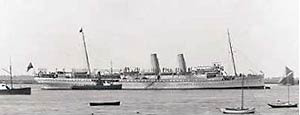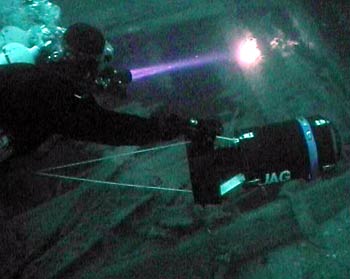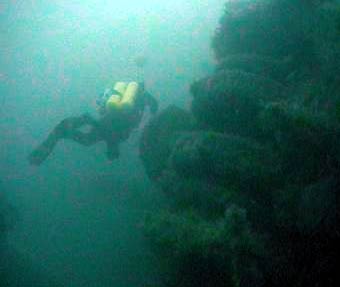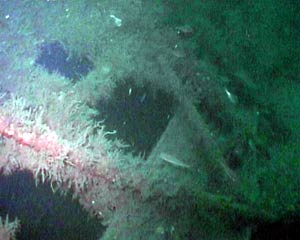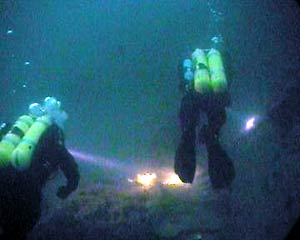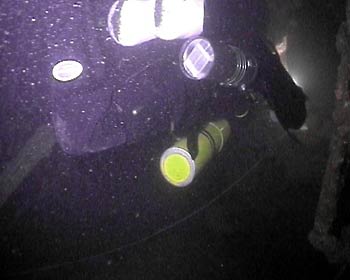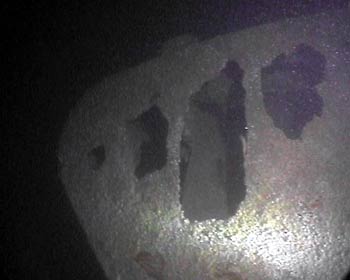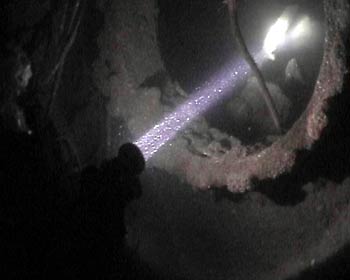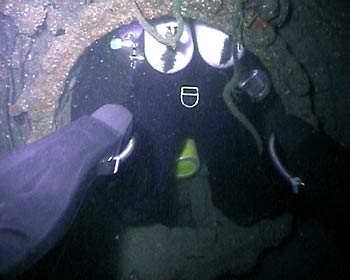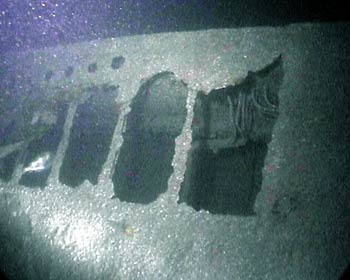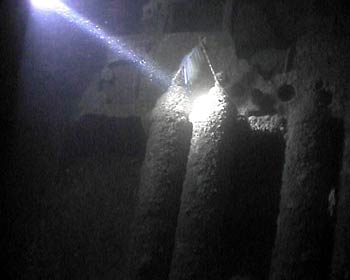DIR Diving in the UK: World War Wrecks
DIR Diving in the UK: World War Wrecks
DIR Diving in the UK: World War WrecksBY JOHN GROGAN The 20th century has left a legacy that delights many wreck divers in the UK. Two world wars as well as many storms have resulted in thousands of shipwrecks along the south coast. As a result, it has become a magnet for divers, with wrecks ranging in depths from as shallow as 12m (40ft), to as great as 100m (330ft). The English Channel gets deeper as one moves westward, with a maximum depth of about 45-50m (148-165ft) in the east to in excess of 100m (330ft) off Cornwall in the west. There are a number of deep holes that extend to as deep as 180m (595ft), some of which also harbor wrecks. However, given the nature of these dives, they are almost never visited.
The prolificacy of dive stores, dive boats and dive clubs along the south coast means that it is possible to charter boats along the whole length of the channel, with more and more dive stores providing Trimix. One of the more popular destinations for wreck divers is Weymouth/Portland at the east end of Lyme Bay. From here, there are in excess of 100 wrecks within a 2-hour boat ride. During the First World War, U-boats were only in serious danger passing through the Dover straits. Once they had broken through, they could largely attack with impunity. With the advent of the Second World War, however, technology had improved considerably, and the Royal Navy began using SONAR to detect U-boats. The result was that it was extremely difficult for submarine crews to escape being depth charged. Consequently, U-boat attacks on shipping were scarce, with most U-boats choosing to operate in the Atlantic and Northern waters instead. This meant that the greater threat to allied shipping in the Channel came from the Luftwaffe and E-boats (fast attack boats), rather than U-boats.
As a result, many of the large shipwrecks, especially liners that were U-boat war casualties, were sunk in the First World War. There are fewer such casualties from the Second World War in the Channel. In this article, we will look at some victims of both wars. Launched in 1908, the Salsette was an express mail liner owned by the P&O line. On her fated final voyage, she carried 31 passengers and 20 tons of general cargo from London to Bombay. She was once described as one of the most beautiful straight-stemmed steamers ever built. There were 600 brass portholes on her white hull; with her yellow funnels, she looked more like a luxury yacht than a liner. At 440ft long, with a beam of 53ft and 10,000hp engines driving her twin screws, her top speed was 20 knots. On her maiden voyage, she broke the Marseilles -- Bombay record, and later went on to break other records. At one point she even held the Blue Ribband for the fastest transatlantic crossing.
When the First World War broke out, she became a prized asset. The fastest U-boat could only manage 13.5 knots, so she could leave any submarine standing. Rumour has it that the German high command had put a price on her head, offering the reward of promotion for any crew that sank her. On 20 July 1917, as she approached the east side of Portland Bill, she was spoken to on semaphore by torpedo boat 85 who instructed her to keep 4 miles south of the Bill due to mine laying operations. She complied, and having cleared the Bill, she turned NW into Lyme Bay bringing her speed up to 16.4 knots. With calm conditions in Lyme Bay, the liner was following a standard zigzag pattern. Oberleutant Howaldt, on UB-40, had spotted her and positioned himself so that the ship would pass close by. The plan worked. One torpedo was fired, which was spotted in-bound by Mate Arthur Vaughn who shouted hard to starboard. But it was too late. The torpedo struck the liner amidships on the starboard side killing 15 crewmembers. It destroyed everything in its path including a number of lifeboats. An immediate order to abandon ship was given, and 15 minutes after being hit, the majestic liner listed to port and slipped under the waves.
Today, the wreck lies with a 45-degree list to port. She starts at about 30m (100fsw) with the deepest bit lying in about 47m (155fsw). Having been discovered in the early 1970's, many brass and ferrous artefacts have been taken from the wreck. Much of the superstructure has collapsed onto the seabed; as a result, little remains other than the decking. There are many penetration points through cargo holds and other access points. By and large, the hull is still very much intact, with one section near the bow and another near the stern where there are large holes. Her masts, funnels and crane lie on the seabed away from the wreck. The RMS Medina was a majestic liner built in 1911. She displaced 12,358 tons, and was 550ft long with a beam of 63ft. Originally designed for the London to India run, she carried general cargo and passengers.
With the outbreak of war in 1914, she was subsequently fitted with deck guns with which to defend herself. In the early stages of the war, U-boats would surface close to their target and provide ample warning for the crew and passengers to abandon ship before sinking her. In many cases, the ships' guns were disguised, and a number of U-boats had the surprise of being fired upon. This resulted in U-boats torpedoing their targets without providing any warnings. In 1917, the Medina was returning from India via Alexandria, Egypt. The Viceroy of India, Lord Carmichael, was returning to England and was having his personal possessions carried back on the Medina – having elected to take a safer path home. His possessions included his Knight Grand Commander of the Indian Empire medal, his art collection, as well as many other valuable personal artifacts. The cargo manifest also included tons of copper, tin and gold ingots. The ship had docked at Plymouth to offload the gold due to the submarine threat in the Channel. On 28 April 1917, the Medina approached Anvil Point. She was spotted by UB31, and with perfectly calm conditions she presented an easy target. A single torpedo was fired, impacting at the engine room at 6:05pm. Six engine crewmen died in the explosion, with the remaining 411 passengers and crew surviving. She quickly settled in the water and an order to abandon ship was given. By 6:50 she was completely abandoned, and at 7:28, she sank beneath the waves.
Due to the nature of the cargo that was on board, there were a number of salvage attempts made over the years. The first group was Risdon Beazley, who actually worked the wreck for a parcel of twenty-five tons of tin in 1973 and 1975, with a cursory search for a hundred tons of copper in an unknown stowage. A memorable feature of that job was grabbing down to the bottom of the holds through passengers' baggage. Even after sixty years of immersion, clothes in the center of some of the trunks were still dry, and many remarkable souvenirs came up, including the elaborate dressing-table sets of those days, comprising up to ten cut glass bottles and jars with metal or enamel lids matching the brushes, combs and mirrors. The price of copper was low at that time and, not having the luck to find the stowage quickly, Risdon Beazley gave up. After the famous Far Eastern recovery of porcelain in the "Nanking Cargo," another attempt was made to search the Medina-- this time for the "Viceroy's Treasure." The owner of this supposed hoard was in fact Sir Charles Monro, the retiring governor of Bengal, who had been a collector of antiquities. This search was probably based on the inference that his luggage might contain a large value in oriental objets d'art. In fact, Sir Charles, as a VIP, had transshipped to a cruiser at Alexandria for a safer run home through submarine-infested waters. This meant that there was not much of his baggage on the Medina anyway. After months of work, the subsequent sale of recovered artifacts raised £22,000. In 1984, Consortium Recovery Ltd., armed with the most up-to-date diving equipment, decided to try and locate Lord Carmichael's possessions. Although no insurance papers survived, it was felt that there would be a large number of works of art in his Medina baggage. Despite plans of the ship having been destroyed, working from the plans of a sister ship, the likely location of Carmichael's baggage was estimated. Preliminary explorations revealed that the wreck had been distorted by previous salvage operations; work was later abandoned because of severe weather. In late 1986, the project was resurrected. Work was carried out twenty-four hours a day because of the great expense of the operation. Pairs of divers worked eight-hour shifts from a diving bell lowered 220ft to the wreck. While off duty they remained in pressurized chambers within the ship to avoid time-wasting daily decompression. Although protected from the intense cold by specially heated suits, the divers faced the hazard of unstable decks and compartments filled with thick mud. Several times they cut through the steel only to find cases of rotting butter and meat. It was decided to abandon the project until, on a final descent, one of the divers came on a box marked "GCIE"(Knight Grand Commander of the Indian Empire) - proof that they had at last found Lord Carmichael's belongings. There was, as expected, a large Oriental art collection: Indian brassware and an elaborate wooden chair; Japanese porcelain; netsuke; Chinese carving. The mud had left many objects in an extraordinarily good state of preservation; Consortium's conservation team stabilized all items. There are readable letters from Kitchener and Lord Rosebary, watercolors, and even an old Sotheby's coin catalogue. A boot, jars of scent, and perfectly sharpened pencils were brought to the surface. An Assyrian cuneiform seal and bright Ancient Egyptian beads, striped in gold, emerged from the deep. So did Lord Carmichael's Masonic jewels and his KCMG order. There was also a good deal of jewelry: amethyst and diamond cufflinks, and fiery Australian opals, which were just beginning to be mined in the first decade of the century, when Lord Carmichael was Governor of Victoria. Today, the RMS Medina remains remarkably intact given the long time spent on the seabed and the extensive salvage work done over the years. She lies close to Anvil Point in 67m (221fsw) with a slight list to port. The main deck is at 55m (181fsw) with some of the top decks in 38m (125fsw). There are a number of access points leading down to the cargo holds; these allow divers to drift down through 4 or 5 deck levels of this magnificent ship. There is significant silting and buildup of mud inside, so good technique is important. Care is advised due to the gradual collapse of some decking and bulkheads. Most of the damage is at the stern, which sinks further into the mud each year. This wreck is best done with scooters, allowing the diver to truly appreciate the size of this ship.
The U-772
On 29 December, the submarine sighted convoy TCB21 on route to Fowey in Cornwall from Cherbourg in France. Within minutes an explosion ripped through the USS Arthur Sewell. Two minutes later, a torpedo hit the Black Hawk (US Liberty ship) near the stern and almost severed the ship in two. The escort HMCS Calgary responded with depth charges.
At the time it was thought she was sunk by depth charges dropped from a Canadian Wellington aircraft (RCAF Squadron 407) in the middle of the English Channel at a position 20 miles further south. However, more recent evidence suggests that this might not have been the case, as there is no submarine wreck in the reported area and the U-772 now lies only 1 mile from the wreck of the Black Hawk. It is now thought that the counter-attack by HMCS Calgary was responsible for the sinking of U-772. Today, the wreck of the U-772 lies in 54m (178fsw) just a few miles south of Portland Bill. She lies upright with a slight list to port and is pretty much intact. The submarine sank with a loss of all 48 crew and the interior is now largely full of gravel, sand and silt. There is a large hole on the port side, just forward of the conning tower and towards the bow, where the battery units that powered the electric motors are clearly visible; penetration is wider but limited to only 10m or so. Penetration from the conning tower towards the stern is through a bulkhead lockout door about 80 to 90 centimetres (34 inches) in diameter. This bulkhead is closely guarded by a very large conger eel - which may explain why only 1 of the 3 teams made any penetration in that direction.
Given the relatively short length of the U-boat and minimal currents, it is easy to circle around the entire wreck in 10 to 15 minutes. Highlights include the impressive view of the bow looking back along the length of the U-boat, the propellers (two on one shaft), the rudders and the conning tower. Shoals of fish, at least one blue lobster and several large conger eels now inhabit the wreck.
Local Information The history of the Medina came from "Riches From Wrecks - The Recovery Of Sunken Cargoes" by Fergus Hinds (ISBN 0 85174 623 3). One can find further information on the Medina and Salsette in "World War One Channel Wrecks" by Neil Maw (ISBN 0 946020 29 9). Thanks to Paul Larrett for the research on the U-772. |

